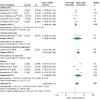Association of Arterial Hyperoxia With Outcomes in Critically Ill Children: A Systematic Review and Meta-analysis
- PMID: 34985516
- PMCID: PMC8733830
- DOI: 10.1001/jamanetworkopen.2021.42105
Association of Arterial Hyperoxia With Outcomes in Critically Ill Children: A Systematic Review and Meta-analysis
Abstract
Importance: Oxygen supplementation is a cornerstone treatment in pediatric critical care. Accumulating evidence suggests that overzealous use of oxygen, leading to hyperoxia, is associated with worse outcomes compared with patients with normoxia.
Objectives: To evaluate the association of arterial hyperoxia with clinical outcome in critically ill children among studies using varied definitions of hyperoxia.
Data sources: A systematic search of EMBASE, MEDLINE, Cochrane Library, and ClinicalTrials.gov from inception to February 1, 2021, was conducted.
Study selection: Clinical trials or observational studies of children admitted to the pediatric intensive care unit that examined hyperoxia, by any definition, and described at least 1 outcome of interest. No language restrictions were applied.
Data extraction and synthesis: The Meta-analysis of Observational Studies in Epidemiology guideline and Newcastle-Ottawa Scale for study quality assessment were used. The review process was performed independently by 2 reviewers. Data were pooled with a random-effects model.
Main outcomes and measures: The primary outcome was 28-day mortality; this time was converted to mortality at the longest follow-up owing to insufficient studies reporting the initial primary outcome. Secondary outcomes included length of stay, ventilator-related outcomes, extracorporeal organ support, and functional performance.
Results: In this systematic review, 16 studies (27 555 patients) were included. All, except 1 randomized clinical pilot trial, were observational cohort studies. Study populations included were post-cardiac arrest (n = 6), traumatic brain injury (n = 1), extracorporeal membrane oxygenation (n = 2), and general critical care (n = 7). Definitions and assessment of hyperoxia differed among included studies. Partial pressure of arterial oxygen was most frequently used to define hyperoxia and mainly by categorical cutoff. In total, 11 studies (23 204 patients) were pooled for meta-analysis. Hyperoxia, by any definition, showed an odds ratio of 1.59 (95% CI, 1.00-2.51; after Hartung-Knapp adjustment, 95% CI, 1.05-2.38) for mortality with substantial between-study heterogeneity (I2 = 92%). This association was also found in less heterogeneous subsets. A signal of harm was observed at higher thresholds of arterial oxygen levels when grouped by definition of hyperoxia. Secondary outcomes were inadequate for meta-analysis.
Conclusions and relevance: These results suggest that, despite methodologic limitations of the studies, hyperoxia is associated with mortality in critically ill children. This finding identifies the further need for prospective observational studies and importance to address the clinical implications of hyperoxia in critically ill children.
Conflict of interest statement
Figures


References
-
- Helmerhorst HJF, Roos-Blom M-J, van Westerloo DJ, de Jonge E. Association between arterial hyperoxia and outcome in subsets of critical illness: a systematic review, meta-analysis, and meta-regression of cohort studies. Crit Care Med. 2015;43(7):1508-1519. doi:10.1097/CCM.0000000000000998 - DOI - PubMed

